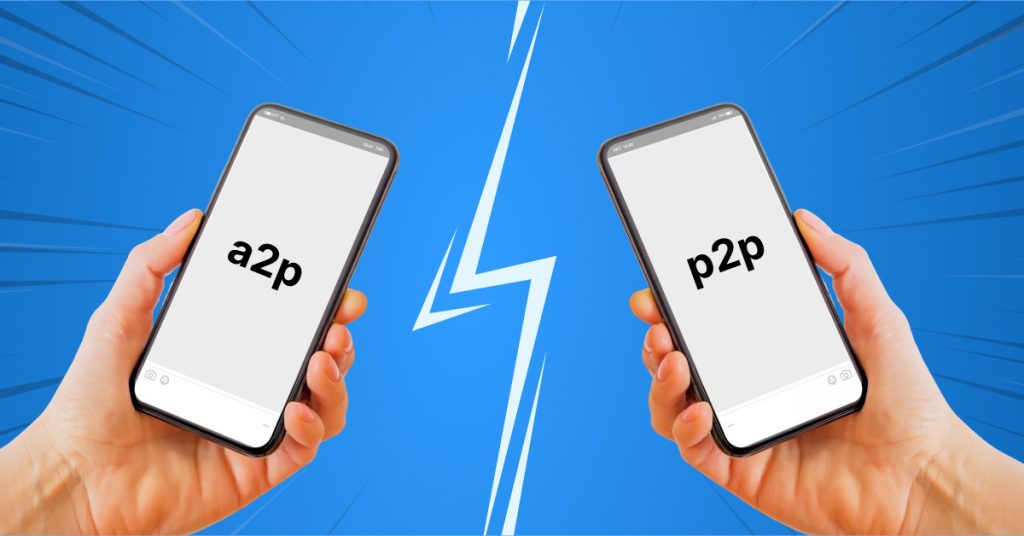
A recent study shows that 90% of customers value quick responses and high-quality communication as key factors in their overall experience. In fact, 86% are willing to pay more for better customer service. Clearly, communication can make the difference between a positive and a frustrating experience.
Whether it’s about delivering targeted marketing messages or providing timely customer support, it is important to choose the right messaging strategy. A2P and P2P SMS serve different use cases, and thus, understanding ‘when’ to use ‘which’ can make all the difference. So, which one is right for you? Let’s delve into A2P vs P2P messaging.
What is A2P Messaging?
A2P stands for Application-to-person messaging. An A2P SMS is a text message sent to a person or customer by a software application (business). Unlike a friendly conversation between two individuals, A2P messaging feels automated. These messages are often sent timely and in relevance. In other words, A2P messages are not friendly conversations, rather, these messages are often broadcasted by businesses to send information to their customers.
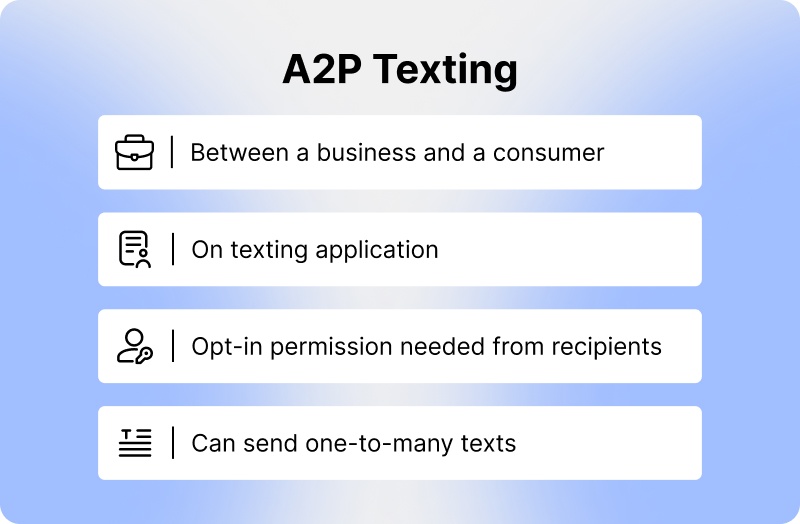
Although, A2P messaging is generally considered a one-way communication channel, it can also support two-way communication in certain scenarios. Here’s the explanation: Traditionally, A2P SMS messages were used by businesses to deliver information without expecting a response from the audience. Some common examples of one-way SMS communication include order confirmations and appointment reminders.
However, with advancements in technology and the rising need to enhance customer engagement among businesses, two-way A2P messaging came into usage, enabling interactive and dynamic conversations. For example, appointment rescheduling and customer support are two-way messaging communication where customers respond and the system handles replies intelligently.
Key Features of A2P Communication
A2P comes with various powerful features that makes it ideal for business messaging and boosting customer engagement. Let’s have a look at the core features of A2P messaging.
- Higher Volume
A2P enables businesses to send SMS communication in bulk volume. Companies with large subscriber bases can benefit by sending information to thousands and even millions of recipients simultaneously.
- Delivery Reports
A2P messaging provides detailed delivery reports for tracking message status. By checking whether the messages are delivered, failed, or queued, companies or businesses can optimize their communication strategies.
- Security & Compliance
A2P messaging implements data encryption and compliance with global regulations, including GDPR and TCPA. This helps protect against unwanted threats.
- Intelligent Routing
A2P utilizes advanced routing algorithms to ensure the delivery of messages through the most reliable and cost-effective paths.
- Automated Scheduling
A2P facilitates message scheduling, enabling businesses to send SMS campaigns at optimal times based on business requirements. This allows for effortless management of recurring campaigns, reminders, and follow-ups.
- API Integration
A2P provides REST APIs and SMPP to integrate seamlessly with existing business systems such as CRMs and ERPs, enabling automated workflows.
- Dynamic Content
A2P supports customized messages with placeholders to personalize SMS based on user data. Enhance user engagement by delivering relevant and targeted content.
- Two-Way Communication
As explained before, A2P enables two-way interaction, allowing customers to reply to A2P messages, typically for feedback collection, surveys, or inquiries.
- Analytics & Insights
A2P offers detailed analytics and reporting on delivery rates, open rates, and user responses. This enables businesses to identify patterns and trends and accordingly rework their messaging strategies.
What is P2P Messaging?
P2P stands for Person-to-Person messaging. It is the regular texting that people do. For example, if you send an SMS to your friend, that’s a P2P message. These messages are typically direct, i.e., one person to another, contain personal information or messages, and are usually exchanged in real time. This type of messaging differs entirely from automated A2P messaging, which we discussed above.
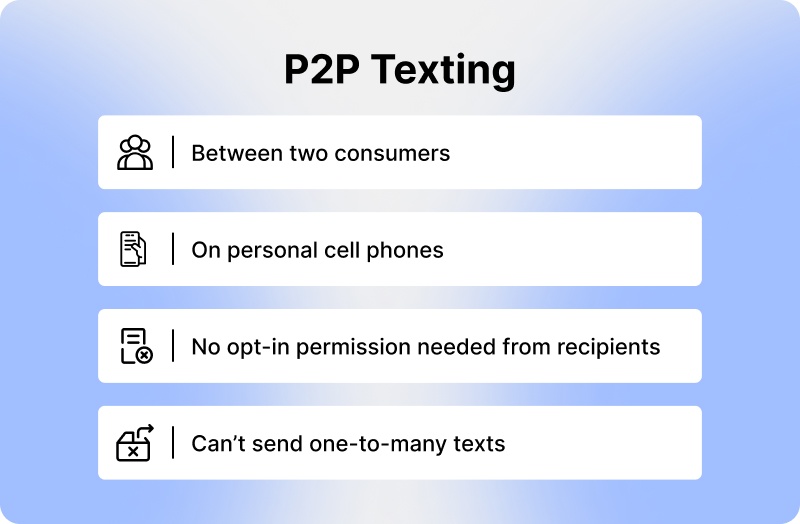
In simple words, we can say that P2P messaging is personal communication or human-to-human communication. In P2P messaging, there are fewer restrictions in terms of throughput and compliance. These messages are typically low-volume and are transmitted between parties in real time.
Key Features of P2P Messaging
We know that P2P is all about user-to-user conversations. Therefore, the features of P2P are tailored to provide direct, secure, and real-time interactions.
- Real-Time Communication
P2P messaging facilitates real-time back-and-forth communication between two individuals, making it conversational and dynamic. This makes it ideal for communication where an immediate response is required. For example, friends communicate via SMS to plan the date and place for an outing. In the business context, a customer representative answering a client’s questions about a product in real time can use P2P.
- More Privacy
P2P interactions offer a higher degree of privacy compared to A2P. This is because P2P messages are exchanged directly between the sender and the recipient.
- Minimal Delay
P2P messaging faces lesser filtration, unlike A2P, and thus is delivered almost instantly.
- Lesser Regulation
In P2P, there are fewer compliance hurdles because it is for personal use.
- Lesser Volume
Since P2P is exchanged between individuals, there is minimal overload. This feature helps keep interactions personalized, focused, and meaningful.
A2P vs P2P Messaging: Key Differences
While A2P messaging sounds more like a broadcast down from a loudspeaker to a huge crowd, P2P is more like a personal or quiet conversation between two friends. The image below highlights what P2P and A2P messaging look like:
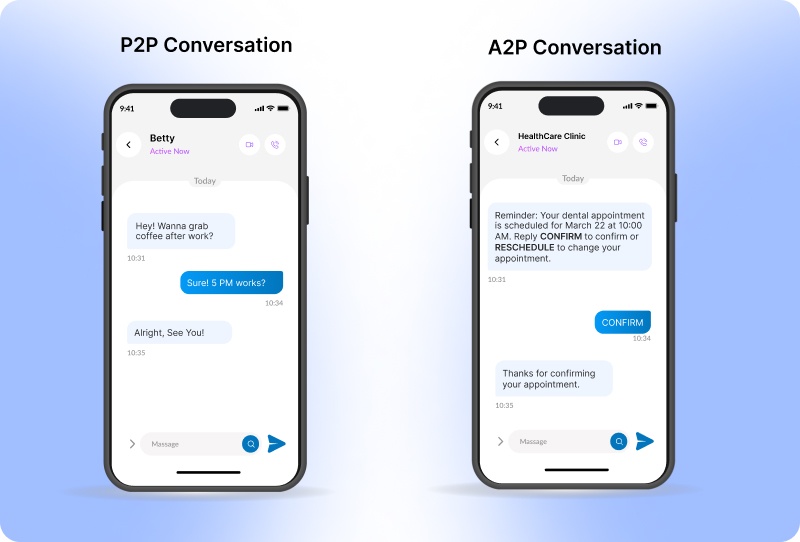
Clearly, the tone of the messages in both cases signifies the difference between these two types of messaging.
Now, let’s consider some other aspects of the differentiating factors between A2P messaging and P2P messaging:
- Messaging Volume
These are generally high volume and high throughput messages, i.e., hundreds, thousands, and even millions of messages can be sent per day. A2P SMS is ideally used for bulk notifications and marketing campaigns. P2P messaging generally involves low volume because it’s limited to user-to-user messaging.
- Sender Types
A2P messages are sent from a software or business application to a user. P2P messages are sent by an individual user to another user, like a friend texting another friend.
- Delivery Speed & Reliability
Since A2P texting is meant for business communication, it ensures fast and reliable delivery of SMS messages at scale through enterprise-grade messaging infrastructure. On the other hand, the speed of P2P texting is generally fast and depends upon the carrier, it is not designed for bulk messaging.
- Regulations
There are several acts and policies that regulate A2P messaging, like the user opt-in and opt-out options. P2P, on the other hand, is mildly regulated since it’s considered private communication between users.
- Automation
Modern SMS platforms offer automation features in A2P messaging. However, P2P is completely manual, i.e., messages are exchanged between users in real-time.
A2P vs P2P: Ideal Use Cases
Understanding the ideal use cases for A2P and P2P can be a good way for businesses to choose the right communication channel. Let’s see where each type of messaging fits best:
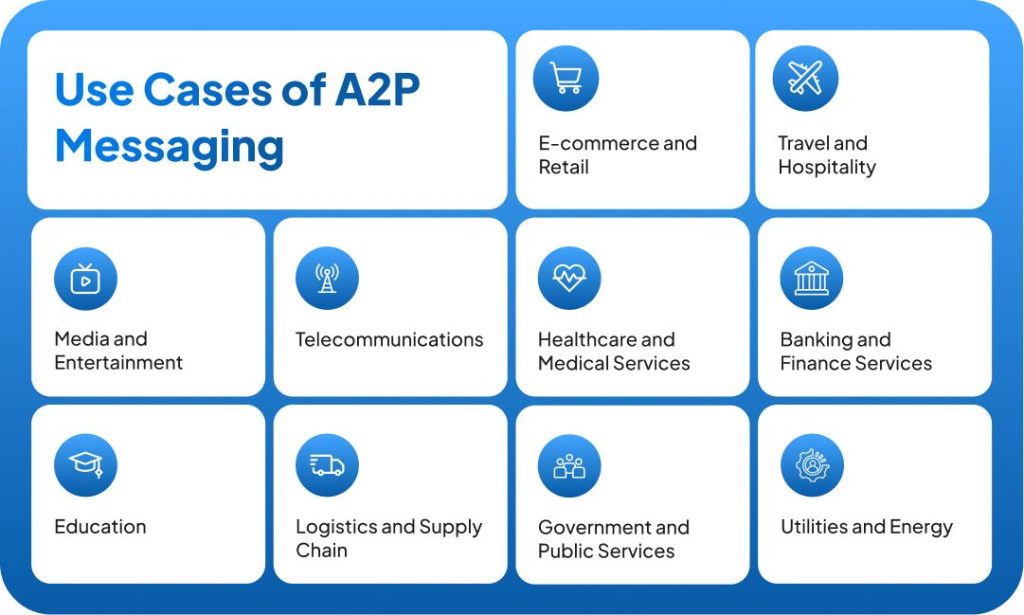
A2P Use Cases
E-commerce and Retail
Companies use A2P SMS for sending order confirmations, shipping notifications, delivery status updates, and estimated arrival times to customers. Some other scenarios where A2P is used in the e-commerce and retail industry are abandoned cart reminders, exclusive discounts, and loyalty offers.
Banking and Finance Services
Financial institutions leverage A2P to enhance security, streamline communication, and notify customers about critical transactions. Some common scenarios where A2P is used by banks and finance companies include sending OTPs for secure account logins, fraud alerts, payment confirmations, balance updates, bill payment reminders, and due date alerts.
Healthcare and Medical Services
Healthcare institutions such as hospitals, clinics, and medical centers use A2P to improve patient engagement by providing appointment reminders, confirmations, and rescheduling. Additionally, prescription refill reminders, lab test notifications, follow-up instructions, and general wellness tips are some other use cases of A2P.
Telecommunications
Telecom companies use A2P SMS to send account-related notifications and security alerts to customers. Also, the application-to-person messaging is done to inform customers about the latest promotional offers, plan upgrades, bill reminders, and payment confirmations.
Travel and Hospitality
A2P messaging finds extensive usage in the travel and hospitality industry. These messages are used to send booking confirmations, itinerary updates, check-in and boarding alerts, and notifications about loyalty programs and exclusive discounts for customers.
Media and Entertainment
Businesses dealing in media and entertainment leverage A2P to send information like subscription renewals and payment reminders to customers. Also, upcoming events and digital tickets are promoted via SMS. Furthermore, content recommendations, such as suggesting movies, songs, etc., based on user preferences and notifying users about new or trending content, are done through A2P.
Education
The role of A2P in the education sector is quite significant, as universities, institutes, and schools use A2P for admission and enrollment notifications. A2P bulk messaging also notifies parents and students about class and exam schedules and sends reminders about assignment due dates. Last but not least, A2P SMS is used to send fee payment reminders and scholarship updates to students.
Logistics and Supply Chain
There are various scenarios in the logistics and supply chain where A2P is used. Some common instances include order and delivery tracking, inventory and stock alerts, and pickup and drop-off confirmations.
Government and Public Services
A2P is extensively used in government and public services departments. From emergency alerts, public safety notifications, voter registration, and election reminders, public health campaigns and surveys to collect public feedback are performed using A2P.
Utilities and Energy
This sector also relies heavily on A2P messaging for delivering information to customers. Sending bill and payment reminders, outage alerts, and service updates, sharing usage reports, and suggesting energy conservation tips – all the communication is done using A2P SMS.
P2P Use Cases
- Personal Communication, i.e., texting between friends and family
- Peer-to-peer coordination, like colleagues planning a day out
- Colleagues quickly exchange work-related updates quickly via P2P
Pros and Cons of A2P and P2P Messaging
A2P and P2P messaging serve different communication needs, and both come with their own set of advantages and limitations. Let’s discuss those here, one by one:
Benefits of A2P Messaging
The global A2P messaging market size was estimated at USD 71.50 billion in 2024 and is projected to grow at a CAGR of 5.4% from 2025 to 2030. Source
It is because of the wide-ranging benefits of A2P that businesses are increasingly relying on it as a power communication channel to boost their growth.
- Better Customer Engagement & Stronger Customer Loyalty
The instant nature of SMS makes it possible for businesses to connect quickly with their audience and create a seamless experience. This is a key point in boosting customer satisfaction and transforming casual customers into long-term brand advocates.
- Saves Time, Reduces Costs, and Boost Efficiency
A2P messaging automates repetitive communication like appointment reminders and payment confirmations, helping businesses to utilize resources in other crucial areas.
- Increase Visibility, Achieve Greater Impact
SMS boasts impressive open rates, which means businesses can get their message read by the maximum number of recipients. This is a key factor in driving more customer engagement and thus achieving better results.
- Reliable, Direct, and Spam-Free Communication
A2P messaging adheres to carrier regulations and thus bypasses spam filters and is delivered straight into the recipients’ inboxes. With this, it is ensured that critical information such as product updates, promotions, and alerts always reach the customers exactly when needed.
Limitations of A2P
- Strict telecom regulations and anti-spam laws
- Character restriction (usually 160 characters)
- Dependency on Opt-in lists
Benefits of P2P
- Natural & Human-Like Communication
- Quick exchange of information
- Messages from known contacts lead to high engagement
Limitations of P2P
- Not Scalable for Businesses
- Regulatory Concerns at Scale
- Message Delays or Filtering on Some Networks
How REVE SMS can Help?
Our SMS solution, REVE SMS Platform, is a carrier-grade solution designed to provide aggregators, MNOs, and MVNOs with seamless support for A2P, P2A, and P2P messaging services. Our platform integrates a robust real-time billing system that ensures accurate invoice generation. Here are some more outshining features of the REVE SMS Platform:
- Seamless Multi-Protocol Support SMPP, HTTP, HTTPS, RESTful API, and SS7 (SIGTRAN M3UA, SCCP).
- Ensures effortless management of dynamic as well as generic SMS campaigns.
- Supports advanced routing algorithms for optimal processing of millions of messages per hour.
- Client and reseller management is made extremely easy with an interactive dashboard, multi-tier reseller management, a client-specific reporting portal, and online payment options.
- Various options are available that make bundle/ package management completely hassle-free.
- Content whitelisting, blocking, and modification can be performed easily.
- Facilitates advanced MNP Dipping Management and HLR Lookup Support for optimal routing and service efficiency.
- Fast and simple price management, along with real-time rate updates, make it the all-in-one solution for retail and wholesale SMS trading.
Conclusion
The very first thing we learned through this post about A2P vs P2P is the meaning and working these type of messaging . While A2P excels in scenarios where automation, speed, and scalability are key drivers, P2P is ideal for environments where personalization, real-time interactions, and two-way communication are paramount. The combination of these two i.e., A2P and P2P messaging, can be particularly useful for businesses aiming to optimize customer interactions.
Frequently Asked Questions
What is the purpose of A2P and P2P SMS?
A2P SMS is primarily used by businesses and organizations to send automated messages to customers. These messages are typically in the form of alerts, notifications, promotions, and transactional updates. The very goal of using A2P SMS is to deliver timely, relevant information to a large audience without much hassle. On the contrary, P2P is meant for personal communication between individuals, such as chats between friends.
Is there any SMS delivery speed difference between A2P and P2P?
Yes, A2P messages typically have a faster delivery speed. This is because of the presence of direct carrier connections and priority routing. On the other side, P2P messages are still fast, however, these messages may experience slight delays due to network availability and recipient response times.
What is the ideal SMS type for one-way communication?
For any type of one-way communication, A2P SMS is the perfect choice. Businesses often leverage A2P messaging to send bulk messages, notifications, alerts, etc., wherein no response is expected from the recipients.
Can P2P be used for business purposes?
No, businesses should not use P2P SMS. There are two reasons for this:
- P2P is not designed for large-scale messaging. Using P2P for high-volume messaging can lead to delivery delays, which can affect the working of the business.
- If carriers detect misuse of P2P messaging and violation of carrier/ messaging laws, then they can block or suspend SMS services for the business.
What happens if A2P SMS violates compliance rules?
Violation of SMS compliance rules such as GDPR, TCPA, etc., can lead to severe consequences such as message blocking, penalties, and even service suspension.




























